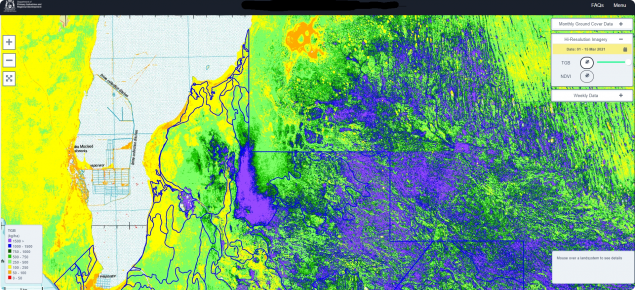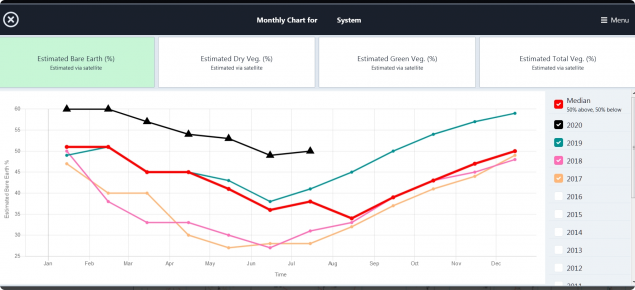Who is PRS for?
PRS is for pastoralists and others interested in sustainable pastoral management.
The Department of Primary Industries and Regional Development (DPIRD), in partnership with Landgate, developed this Pastoral Remote Sensing (PRS) application to assist pastoral land managers. By using this application, managers can make more-informed management decisions to improve profitability and sustainable use of pastoral resources.
We recommend that you read all of the information on this page before linking to the PRS application for the first time.
If you have visited this page before, and understand how to use the PRS information, you can go straight to the application.
Open the PRS application |
Which pastoral stations are in PRS?
PRS opens with an alphabetic list of all pastoral stations in Western Australia. Clicking on a station name opens the application with the base map, which has the station boundary and the land system boundaries in the station. If you think something is missing or wrong, please contact us (see below).
The base map for PRS can be either a 1:250 000 topographic map, or a composite aerial photo (use the Menu option in PRS to change the base map). Note that the photo is usually several years old – the date is in the bottom right hand corner of the photo.
Introduction to PRS
These 11 videos explain each section and use of the application. We recommend that you view these before using the application for the first time.
- Using Pastoral Remote Sensing 1 Welcome and Disclaimer
- Using Pastoral Remote Sensing 2 Navigating the site
- Using Pastoral Remote Sensing 3 NDVI – Normalised Difference Vegetation Index
- Using Pastoral Remote Sensing 4 TGB Total Green Biomass
- Using Pastoral Remote Sensing 5 Historical Data Navigation
- Using Pastoral Remote Sensing 6 Fractional Ground Cover Data
- Using Pastoral Remote Sensing 7 Navigating Available Graphs
- Using Pastoral Remote Sensing 8 Understanding Graphed Data
- Using Pastoral Remote Sensing 9 Interpreting Graphed Data
- Using Pastoral Remote Sensing 10 Further Comments on Interpreting Graphed Data
- Using Pastoral Remote Sensing 11 Frequently Asked Questions
What is in PRS for pastoral managers?
Information on seasonal condition and trend
- Monthly ground cover data: is presented for the station's land systems as estimated bare earth %, dry vegetation %, green vegetation %, total vegetation % and satellite imagery for a chosen month of a chosen year. The land systems are in a table on the left hand side when this option is chosen, with the percentages and an icon leading to charts of the estimated monthly ground cover data: bare earth %; dry vegetation %; green vegetation %; totla vegetation % cover.
- High resolution imagery: is presented for a given fortnight and year. The map fills the screen and show the chosen station centred in the region. The image is of either NDVI values, or the estimated total green biomass (TGB). This image has 10 x 10 metre pixels.
- Weekly data: is presented for the station's land systems as mapped normalised difference vegetation index (NDVI or greenness index) categories for the station land systems, NDVI satellite imagery for the region, and estimated total green biomass (TGB). The land systems are in a table on the left hand side when this option is chosen, with the TGB for the period chosen, and the change since the previous week. There is an icon leading to charts of the estimated weekly values: totla green biomass; NDVI; total dry matter; rainfall.
Download PRS station reports
If you have restricted bandwidth and cannot easily view the full PRS application, you can download a summary of the PRS information.
Open PDF station reports |
Using the information in PRS
Most of the information in PRS is estimated using modelling, and is not based on data collected at regular intervals on each station. This means that the information is a guide only, and you should not treat the values in PRS as reality or base management decisions only on the information in PRS.
You can use this information to guide your lease-level decisions by putting current seasonal conditions into perspective.
Interpreting the information in PRS
For information on the terms used, see the Frequently Asked Questions within PRS.
Normalised differential vegetation index (NDVI)
NDVI – normalised difference vegetation index – is an index of greenness seen by the satellite. Essentially, NDVI is an indication of the amount of green vegetation. Much of the information in PRS is based on the NDVI values and modelling of plant growth, which is why the NDVI values and trends are so important.
- NDVI provides an estimate of green vegetation density and health at the time of the satellite run. That is, the more green that the satellite 'sees', the higher the value.
- NDVI can be used (with or without ground measurement) to estimate several factors: green biomass, growing season relative value, fractional vegetation cover, and leaf area index. For accurate estimation of green biomass, NDVI values need to be calibrated with weighed biomass cuts from the target paddock.
- NDVI can be used to show the effects of management and season on vegetation growth.
- NDVI does not estimate feed on offer (FOO), but is correlated with green biomass.
- NDVI does not register dry biomass.
- NDVI does not differentiate between annual or perennial plant growth, or desirable and undesirable green plants.
- NDVI does not indicate pasture condition (mostly because of the points above).
For more information
View the videos (listed above), or open the application and read the frequently asked questions and the answers.
To provide feedback or corrections
Contact us (see below). The intent is to provide new releases as better information is available.


